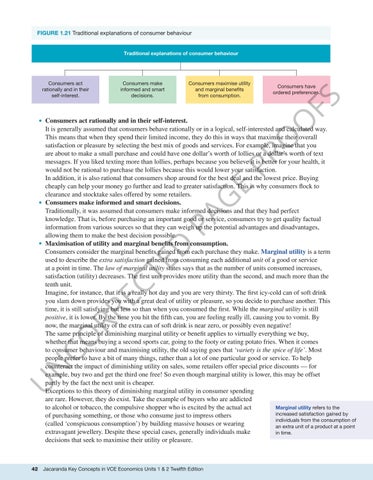“c01ThinkingLikeAnEconomist_PrintPDF” — 2022/7/18 — 23:09 — page 42 — #40
FIGURE 1.21 Traditional explanations of consumer behaviour
Traditional explanations of consumer behaviour
Consumers make informed and smart decisions.
Consumers maximise utility and marginal benefits from consumption.
O
• Consumers act rationally and in their self-interest.
Consumers have ordered preferences.
FS
Consumers act rationally and in their self-interest.
U
N
CO RR EC
TE
D
PA
G
E
PR
O
It is generally assumed that consumers behave rationally or in a logical, self-interested and calculated way. This means that when they spend their limited income, they do this in ways that maximise their overall satisfaction or pleasure by selecting the best mix of goods and services. For example, imagine that you are about to make a small purchase and could have one dollar’s worth of lollies or a dollar’s worth of text messages. If you liked texting more than lollies, perhaps because you believe it is better for your health, it would not be rational to purchase the lollies because this would lower your satisfaction. In addition, it is also rational that consumers shop around for the best deal and the lowest price. Buying cheaply can help your money go further and lead to greater satisfaction. This is why consumers flock to clearance and stocktake sales offered by some retailers. • Consumers make informed and smart decisions. Traditionally, it was assumed that consumers make informed decisions and that they had perfect knowledge. That is, before purchasing an important good or service, consumers try to get quality factual information from various sources so that they can weigh up the potential advantages and disadvantages, allowing them to make the best decision possible. • Maximisation of utility and marginal benefits from consumption. Consumers consider the marginal benefits gained from each purchase they make. Marginal utility is a term used to describe the extra satisfaction gained from consuming each additional unit of a good or service at a point in time. The law of marginal utility states says that as the number of units consumed increases, satisfaction (utility) decreases. The first unit provides more utility than the second, and much more than the tenth unit. Imagine, for instance, that it is a really hot day and you are very thirsty. The first icy-cold can of soft drink you slam down provides you with a great deal of utility or pleasure, so you decide to purchase another. This time, it is still satisfying but less so than when you consumed the first. While the marginal utility is still positive, it is lower. By the time you hit the fifth can, you are feeling really ill, causing you to vomit. By now, the marginal utility of the extra can of soft drink is near zero, or possibly even negative! The same principle of diminishing marginal utility or benefit applies to virtually everything we buy, whether that means buying a second sports car, going to the footy or eating potato fries. When it comes to consumer behaviour and maximising utility, the old saying goes that ‘variety is the spice of life’. Most people prefer to have a bit of many things, rather than a lot of one particular good or service. To help counteract the impact of diminishing utility on sales, some retailers offer special price discounts — for example, buy two and get the third one free! So even though marginal utility is lower, this may be offset partly by the fact the next unit is cheaper. Exceptions to this theory of diminishing marginal utility in consumer spending are rare. However, they do exist. Take the example of buyers who are addicted Marginal utility refers to the to alcohol or tobacco, the compulsive shopper who is excited by the actual act increased satisfaction gained by of purchasing something, or those who consume just to impress others individuals from the consumption of (called ‘conspicuous consumption’) by building massive houses or wearing an extra unit of a product at a point extravagant jewellery. Despite these special cases, generally individuals make in time. decisions that seek to maximise their utility or pleasure.
42
Jacaranda Key Concepts in VCE Economics Units 1 & 2 Twelfth Edition





















































